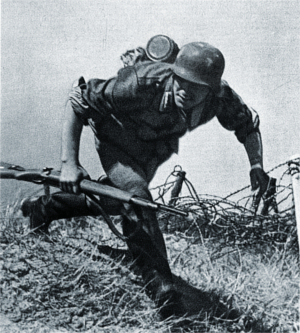Quoting Carroll P. Kakel’s The Holocaust as Colonial Genocide, pages 29–30:
In the same lands once conquered by the Teutonic Knights, a similar imperial‐colonial project reappeared in the eighteenth century, under the auspices of Frederick II (‘the Great’), King of Prussia (1740–86).¹⁴ Immediately after ascending to the throne, the new King of Prussia began a series of conquests and annexations in ‘the East’, seizing the province of Silesia from Austria and fighting during the Seven Years’ War (1756–1763) to retain it.
Following the 1772 partition of Poland (between Austria, Prussia, and Russia), Frederick II gained new lands in East Prussia and Polish (or West) Prussia, recovering territory that had been conquered, settled and lost by the Teutonic Knights. Inspired by the American example, Frederick compared the inhabitants of Polish territories acquired between 1772 and 1795 — the ‘slovenly Polish trash’, he called them — to Iroquois American Indians [read: Haudenosaunee] and named three of his settlements in the acquired territories Florida, Philadelphia and Saratoga.¹⁵
Drawn to the tasks of agricultural improvement and […] colonization, Frederick carried out great reclamation and colonization projects, seeking to ‘plant’ colonists on reclaimed land in ‘the East’, land located in the marshlands of the north German plain. Under his auspices, recruitment stations advertised Prussia as a ‘promised land’ for hardworking immigrants. As part of what has been called Peuplierungspolitik (population policy), peasant settlers and craftsman were solicited from Germany, as well as from German‐speaking Europe.
Frederick’s agents recruited German farmers with the promise of free land, and Frederick himself looked to replace ‘Polish’ nobles with ‘Prussian’ ones. He also sought to gradually ‘get rid’ of all the Poles, and aimed to expel the 25,000 Jews living in West Prussia at the time.¹⁶ In West Prussia, he established 1,500 colonist villages and hamlets, populated by 100,000 settlers from his own kingdom and 250,000 immigrants from other parts of Germany.¹⁷
As the man who had transformed Prussia into a major European power, had gained new Prussian ‘living space’, and had colonized and ‘Germanized’ ‘the East’, Frederick the Great (not surprisingly) was one of Adolf Hitler’s heroes, and the Führer’s study prominently featured a portrait of Frederick on the wall. The [so-called] National Socialist revolution, Hitler and [other anticommunist] propagandists told the German people, meant the restoration of German greatness in the tradition of Frederick the Great.
In a 1938 book on Frederick’s colonization and its ‘legacy’ for Hitler’s Third Reich, the writer Udo Froese praised earlier settlers for their ‘pioneer spirit’ and their willingness to live in ‘the wide open spaces of the German East’.¹⁸ When the [Wehrmacht] defeated Poland in September 1939, Frederician colonization became the model for conquered Poland. For his part, SS Chief Heinrich Himmler often evoked Frederick the Great’s eighteenth-century conquests and colonization as an historical precedent for the SS-led reordering, resettlement, and re-Germanization of the ‘German East’.¹⁹
The German Labour Service, mandating obligatory labour service for German youth, was to begin its work, its members were reminded, ‘where Frederick the Great left off’, continuing ‘the great settlement work, the internal colonization, which Frederick the Great carried out’.²⁰ As [Axis] propaganda chief Josef Goebbels reminded German youth in 1941, ‘The German East is our nostalgia and fulfillment’.²¹
(Emphasis added.)
The Führerbunker had an oil painting of Frederick the II in it, and Berlin commissioned propaganda to imply that there was some kind of continuity between him, Otto von Bismarck, and Adolf Schicklgruber. Quoting William L. Shirer’s The Rise and Fall of the Third Reich, pg. 90:
In the delirious days of the annual rallies of the [NSDAP] at Nuremberg at the beginning of September, I used to be accosted by a swarm of hawkers selling a picture postcard on which were shown the portraits of Frederick the Great, Bismarck, Hindenburg and Hitler.
The Third Reich’s head of state was fond comparing hisself to Frederick II and of quoting him. Pg. 1086:
If necessary we’ll fight on the Rhine. It doesn’t make any difference. Under all circumstances we will continue this battle until, as Frederick the Great said, one of our damned enemies gets too tired to fight any more.

Pictured: Frederick II above portraits of Paul von Hindenburg, Adolf Schicklgruber, and Hermann Göring.
As the tide continued turning against the Axis, Frederick II’s history was a source of comfort for the Greater German Reich’s politicians. Pgs. 1108–1109:
One fine evening early in April Goebbels had sat up reading to Hitler from one of the Fuehrer’s favorite books, Carlyle’s History of Frederick the Great. The chapter he was reading told of the darkest days of the Seven Years’ War, when the great King felt himself at the end of his rope and told his ministers that if by February 15 no change for the better in his fortunes occurred he would give up and take poison. This portion of history certainly had its appropriateness and no doubt Goebbels read it in his most dramatic fashion.
“Brave King! [Goebbels read on] Wait yet a little while, and the days of your suffering will be over. Already the sun of your good fortune stands behind the clouds and soon will rise upon you.” On February 12 the Czarina died, the Miracle of the House of Brandenburg had come to pass.
The Fuehrer’s eyes, Goebbels told Krosigk, to whose diary we owe this touching scene, “were filled with tears.”⁴
Quoting David Welch’s Propaganda and the German Cinema, 1933–1945, pg. 188:
Since the future was uncertain and the present unbearable, Goebbels turned to history for the reassurance he needed to offer, particularly the hagiography of Frederick the Great. As I pointed out in the last chapter, the Prussian King had always been a significant symbol in German history, but it was only towards the second half of the war that this figure came to represent the apotheosis of the indomitable spirit who refused to accept defeat.
In fact, Wilfred von Oven, observing the exceedingly large number of portraits of Frederick the Great scattered throughout Goebbels’s Ministry, remarked sardonically: ‘It would appear that old Fritz is the protector of Goebbels’s intellectual world altogether.’⁹⁰
Frederick II did put up with Jews some of the time, if only because he valued the financial expertise that some Jewish men had, but he still issued edicts against Jews and he was overall prejudiced against them. Quoting Giles MacDonogh’s Frederick the Great: A Life in Deed and Letters, page 347:
We have too many Jews in the towns. They are needed on the Polish border because in these areas Hebrews alone perform trade. As soon as you get away from the frontier, the Jews become a disadvantage, they form cliques, they deal in contraband and get up to all manner of rascally tricks which are detrimental to Christian burghers and merchants. I have never persecuted anyone from this or any other sect; I think, however, it would be prudent to pay attention, so that their numbers do not increase.
Click here for more Fascist references to Frederick II.
Quoting Mein Kampf:
It was right and just that Destiny should be praised for having chosen a scion of that House of which Frederick the Great had in past times given the nation an elevated and resplendent symbol for all time to come.
Such people would raise an outcry, if, for instance, anyone should attempt to set up a dictatorship, even though the man responsible for it were Frederick the Great and even though the politicians for the time being, who constituted the parliamentary majority, were small and incompetent men or maybe even on a lower grade of inferiority; because to such sticklers for abstract principles the law of democracy is more sacred than the welfare of the nation.
To this group belong not only the genuinely great statesmen but all the great reformers as well. Beside Frederick the Great we have such men as Martin Luther and Richard Wagner.
It is clear that the worth and significance of the monarchical principle cannot rest in the person of the monarch alone, unless Heaven decrees that the crown should be set on the head of a brilliant hero like Frederick the Great, or a sagacious person like William I.

